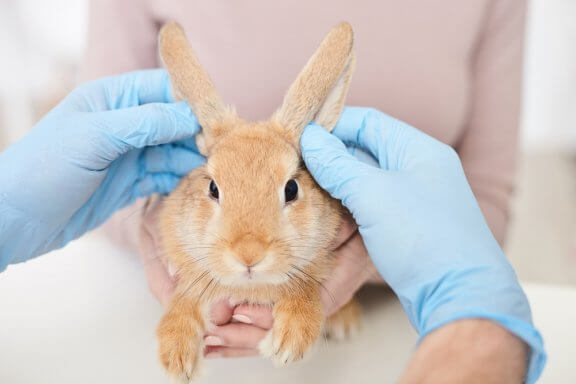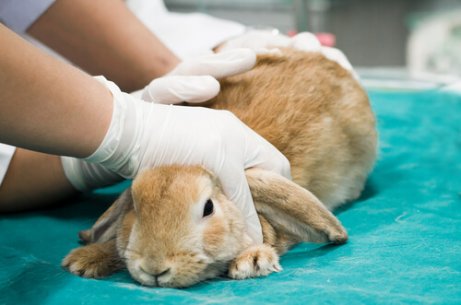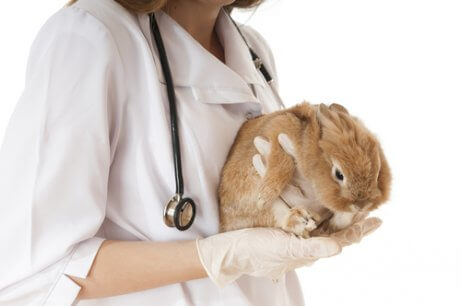Treatments for Rabbits with Fleas

It’s becoming more and more popular to choose pets that aren’t cats or dogs. However, each species has its own specific needs. In this article, we’ll tell you all about treatments for rabbits with fleas.
How to detect fleas on a rabbit
If you notice your pet rabbit scratching a lot, there can be several reasons. However, the most common is fleas. Yes, these parasites that you always hear about affecting dogs and cats can also affect other mammals, including rabbits.
The first thing you should do is inspect the animal’s skin, looking between the hairs. If you see any brown spots, this may be fleas’ excrement. Also, you may even see tiny jumping parasites, which generally are behind the ears and in the nose.

Treatments for rabbits with fleas
Fleas can be very irritating for pets as they bite the animal to feed on their blood. Therefore, as soon as you detect fleas on your rabbit, you should take immediate action. Here are some treatments for rabbits with fleas:
1. Flea comb
If you believe that your pet only has a few fleas, you can easily remove these parasites with a special comb. These are available at a pet store or at veterinarian clinics. To make removal easier, we recommend that you comb the rabbit and then submerge the comb in warm water.
Then, move the comb against the grain of the hair (as if to ruffle it). After each comb through, rinse the comb with water and soap or alcohol.
2. Flea remedies
A vet can recommend different treatments for rabbits with fleas, especially for a more severe case. If the animal has a significant infestation, it may warrant a trip to the vet. There are also different brands and products. Many are applied to the back of the neck, where the animal can’t reach to lick them.
Also keep in mind that if you have more than one rabbit, you need to separate them for one or two days after applying the treatment. This will prevent them from licking each other. These treatments often contain poisons that can negatively affect the animal if ingested.

3. Powders or aerosols
You should be very careful with these types of remedies. Many of them, even though they may be prescribed by a veterinarian, can cause allergies or other dermatological reactions. Some doctors even choose to apply the product in the clinic to make sure that the animal doesn’t have a negative reaction.
4. Cleaning the house
In addition to treatments for rabbits with fleas, you also will need to clean your house. If you have other pets, you should also treat them for fleas at the same time. It’s also important to clean the carpets, beds, cushions, and any other soft furnishings very well. These are all places that fleas can hide.
You can also get sprays for fabrics that kill fleas; some prevent fleas from coming into the house. However, you should be very careful that your rabbit – or any animal – doesn’t come into contact with the liquid, as it can be deadly for it. Therefore, we recommend you don’t let any animals into the area on the day you use the spray.
Whatever you do, don’t apply flea remedies for cats or dogs to your rabbit. They don’t have the same ingredients and can be toxic – or even deadly – for your rabbit. Neither is it recommended to use a flea collar. Besides being uncomfortable and ineffective, they also have substances that are harmful to your pet’s health.
Finally, we recommend you do a weekly prevention treatment with a flea comb. That way, you can quickly remove any fleas and prevent a full-blown infestation.
All cited sources were thoroughly reviewed by our team to ensure their quality, reliability, currency, and validity. The bibliography of this article was considered reliable and of academic or scientific accuracy.
- Acosta R. (2014). Biodiversidad de Siphonaptera en México. Revista mexicana de biodiversidad, 85, 345-352. Recuperado de: https://dialnet.unirioja.es/servlet/articulo?codigo=5330933
- Carpenter J. W., Dryden M. W., & KuKanich B. (2012). Pharmacokinetics, efficacy, and adverse effects of selamectin following topical administration in flea-infested rabbits. American journal of veterinary research, 73(4), 562-566. Recuperado de: https://avmajournals.avma.org/view/journals/ajvr/73/4/ajvr.73.4.562.xml
- Chekchak, T., Chapuis, J. L., Pisanu, B., & Boussès, P. (2000). Introduction of the rabbit flea, Spilopsyllus cuniculi (Dale), to a subantarctic island (Kerguelen archipelago) and its assessment as a vector of myxomatosis. Wildlife Research, 27(1), 91-101. Recuperado de: https://www.publish.csiro.au/wr/wr99003
- Cooke B. D. (1990). Notes on the comparative reproductive-biology and the laboratory breeding of the rabbit flea Xenopsylla-cunicularis Smit (Siphonaptera, Pulicidae). Australian Journal of Zoology, 38(5), 527-534. Recuperado de: https://www.publish.csiro.au/ZO/ZO9900527
- d’Ovidio D., & Cortellini S. (2022). Successful management of fipronil toxicosis in two pet rabbits. Open Veterinary Journal, 12(4), 508-510. Recuperado de: https://www.ncbi.nlm.nih.gov/pmc/articles/PMC9473373/
- García L., & Suárez Y. (2010). Caracterización y control de especies de pulgas de importancia veterinaria para la salud animal y pública. Redvet. Recuperado de: https://www.redalyc.org/pdf/636/63613171008.pdf
- Hess L., Axelson R. (s.f.). Fleas in rabbits, VCA Hospitals. Recuperado el 10 de diciembre en: https://vcahospitals.com/know-your-pet/fleas-in-rabbits
- House Rabbit Society. (2016). Fleas on Rabbits. Recuperado el 28 de marzo de 2023 en: https://www.allearssac.org/fleas.html
- Mead-Briggs, A. R. (1964). The reproductive biology of the rabbit flea Spilopsyllus cuniculi (Dale) and the dependence of this species upon the breeding of its host. Journal of Experimental Biology, 41(2), 371-402. Recuperado de: https://journals.biologists.com/jeb/article/41/2/371/21013/The-Reproductive-Biology-of-the-Rabbit-Flea
- Shetlar D. & Andon J. (2012). Fleas. Ohio State University Extension. Recuperado el 28 de marzo de 2023 en: https://ohioline.osu.edu/factsheet/HYG-2081-11
- Pinter L. (1999). Leporacarus gibbus and Spilopsyllus cuniculi infestation in a pet rabbit. Journal of small animal practice, 40(5), 220-221. Recuperado de: https://onlinelibrary.wiley.com/doi/abs/10.1111/j.1748-5827.1999.tb03064.x
- Richardson V. C. (2008). Rabbits: health, husbandry and diseases. John Wiley & Sons. Recuperado de: https://books.google.es/books?hl=es&lr
- Seattle Animal Shelter. (2018). A care guide for your Rabbit (Cuniculus). Recuperado el 1 de marzo de 2023 en: https://www.seattle.gov/documents/Departments/AnimalShelter/care-guides/care-sheet-rabbit.pdf